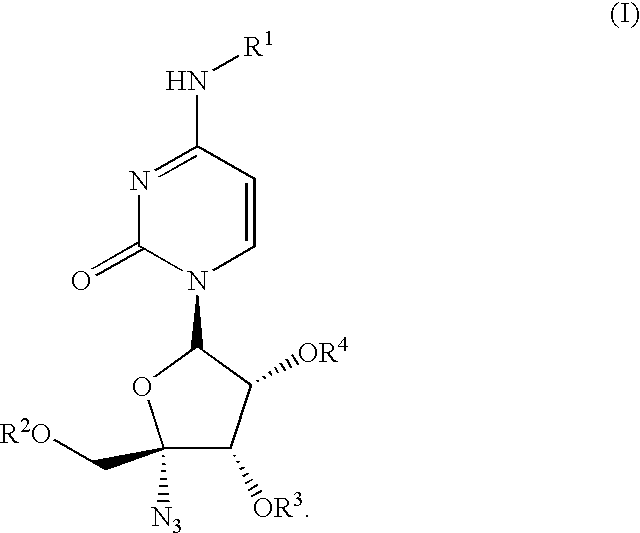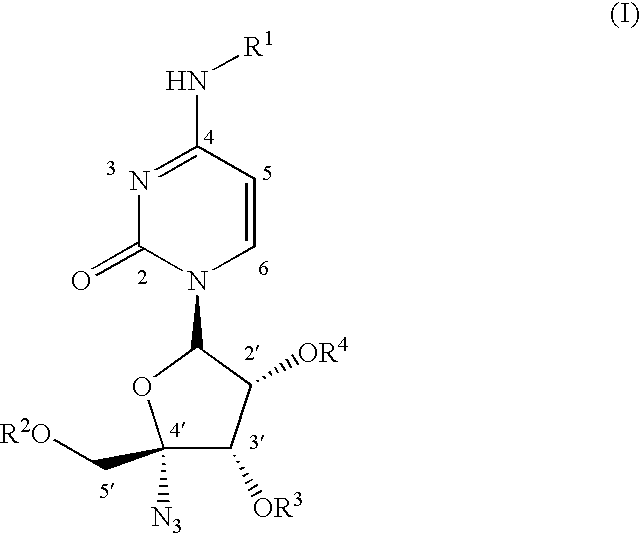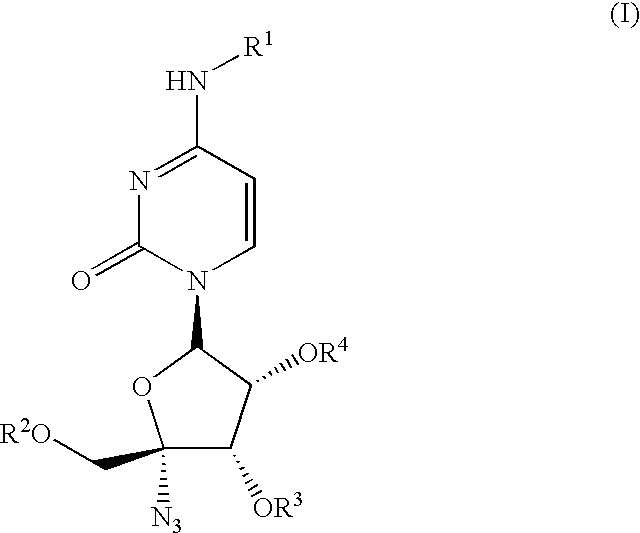Antiviral nucleoside derivatives
a nucleoside derivative and antiviral technology, applied in the direction of sugar derivates, biocides, drug compositions, etc., can solve the problems of limited practical utility and high biological activity of nucleoside derivatives, and achieve poor pharmacokinetics, limited practical utility, and high biological activity
- Summary
- Abstract
- Description
- Claims
- Application Information
AI Technical Summary
Benefits of technology
Problems solved by technology
Method used
Image
Examples
example 1
Method A: Preparation of N, 2′, 3′, 4′-Tetraacyl Nucleoside Derivatives
Acetic acid 3,4-diacetoxy-5-(4-acetylamino-2-oxo-2H-pyrimidin-1-yl)-2-azido-tetrahydro-furan-2-ylmethyl ester
A stirred suspension of 4′-azidocytidine hemisulfate (0.30 g), dimethylaminopyridine (cat.), and N,N-diisopropylethylamine (3.69 mL) in methylene chloride (5 mL), under inert atmosphere, was cooled in an ice / water bath and treated dropwise with acetyl chloride (0.452 mL) and acetic anhydride (0.60 mL). The mixture was allowed to warm to ambient temperature and after 2 days was subjected, untreated, to flash chromatography (50% ethyl acetate in hexanes, then 75% ethyl acetate in hexanes, then 100% ethyl acetate, then 5% methanol in ethyl acetate) to afford 0.335 g of the solid product (compound 1; M+H=453
example 2
Method B: Preparation of N-acyl Nucleoside Derivatives
[1-(5-Azido-3,4-dihydroxy-5-hydroxymethyl-tetrahydro-furan-2-yl)-2-oxo-1,2-dihydro-pyrimidin-4-yl]-carbamic acid butyl ester
A stirred suspension of 4′-azidocytidine hemisulfate (0.50 g) in pyridine (8 mL), under inert atmosphere, was cooled in an ice / water bath and treated with trimethylsilyl chloride (1 mL). The mixture was allowed to warm to ambient temperature and after 1 h was treated with butyl chloroformate (0.2 mL). After stirring another 2 h at that temperature, the reaction was cooled in an ice / water bath and treated with 5 mL aqueous ammonium bicarbonate. The organics were extracted twice with methylene chloride, dried over magnesium sulfate, and filtered. To the filtrate was added tetra-n-butyl ammonium fluoride (0.25 mL, 1 M in tetrahydrofuran). The reaction was stirred at ambient temperature for three days. After solvent removal, the residue was subjected to flash chromatography (25% hexanes in ethyl acetate, then et...
example 3
Method C: Preparation of 2′, 3′, 5′-Triacyl Nucleoside Derivatives
Acetic acid 3,4-diacetoxy-5-(4-amino-2-oxo-2H-pyrimidin-1-yl)-tetrahydro-furan-2-ylmethyl ester (22)
Step 1
To a stirred solution containing 0.330 g (1.15 mmol) 4′-azidouridine, 2 mL pyridine and 2 mL acetic anhydride was added 0.010 g (0.08 mmol) of 4-dimethylaminopyridine. After 12 h, the reaction mixture was evaporated to dryness under reduced pressure. The residue was dissolved in dichloromethane and washed with saturated aqueous sodium hydrogen carbonate solution, dried over magnesium sulfate and evaporated to dryness to give 0.42 g (88%) of 2′,3′,5′-tri-acetoxy-4′-azidouridine (IIIa: R═CH3).
Step 2
POCl3 (0.31 mL; 3.304 mmol) was added to a stirred mixture containing 0.340 g (0.826 mmol) of the uridine, 0.913 g (13.22 mmol) of 1,2,4-triazole and 2.30 mL (16.52 mmol) of triethylamine in 20 mL acetonitrile cooled to 5° C. The reaction mixture was allowed to warm to room temperature. After 12 h, the reaction mixture wa...
PUM
| Property | Measurement | Unit |
|---|---|---|
| Electrical conductance | aaaaa | aaaaa |
| Dimensionless property | aaaaa | aaaaa |
| Dimensionless property | aaaaa | aaaaa |
Abstract
Description
Claims
Application Information
 Login to View More
Login to View More - R&D
- Intellectual Property
- Life Sciences
- Materials
- Tech Scout
- Unparalleled Data Quality
- Higher Quality Content
- 60% Fewer Hallucinations
Browse by: Latest US Patents, China's latest patents, Technical Efficacy Thesaurus, Application Domain, Technology Topic, Popular Technical Reports.
© 2025 PatSnap. All rights reserved.Legal|Privacy policy|Modern Slavery Act Transparency Statement|Sitemap|About US| Contact US: help@patsnap.com



